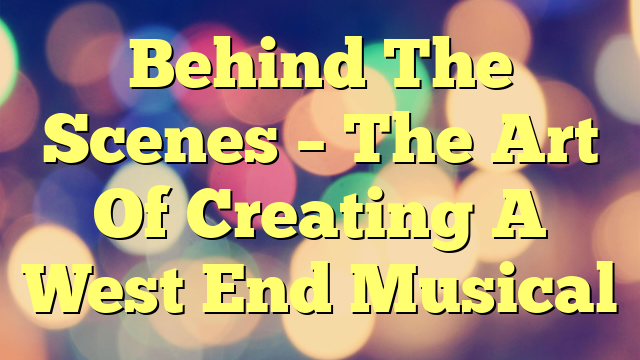There’s a fascinating world that unfolds long before the bright lights hit the West End stage. If you’ve ever wondered what it takes to bring a musical to life, you’re in for a treat. From the initial concept and songwriting to casting and choreography, each element plays a vital role in crafting an unforgettable experience. In this post, you’ll explore the intricate processes and collaborative efforts that transform ideas into a dazzling production, giving you a deeper appreciation for the artistry behind your favorite musicals.
The Conceptualization of a Musical
Before venturing into the world of musical theater, you must understand that the conceptualization phase is where it all begins. This is the stage where a visionary idea takes shape, and every element—music, lyrics, and narrative—starts to intertwine. It’s the time to brainstorm and explore themes that resonate with both the audience and the performers, ensuring the foundation for a memorable production.
The Role of the Writer
An important part of the creation process lies in the hands of the writer. You are responsible for crafting the vision into a compelling narrative, shaping the storyline, and ensuring that the characters speak with authenticity. Your words will ultimately guide the audience through the emotional landscape of the musical, leaving a lasting impact.
Developing the Story and Characters
Around this core narrative, you will be developing intricate characters that the audience can connect with. By giving each character distinct traits, motivations, and arcs, you’re shaping the journey they undertake, allowing for growth and transformation. This is where your creativity shines, as you balance the needs of the story with relatable experiences.
Another significant aspect of developing the story and characters involves understanding the dynamics of relationships within your narrative. Consider how the characters interact, what conflicts arise, and how these elements drive the plot forward. It is vital to create multi-dimensional characters that will resonate deeply with the audience, enabling them to become emotionally invested in your musical. The subtleties of dialogue and character development can make all the difference in capturing and maintaining your audience’s attention throughout the performance.
Music and Lyrics: The Heart of the Show
Even in the glittering world of West End musicals, music and lyrics serve as the heartbeat, infusing life into every performance. They convey emotion, establish characters, and propel the narrative forward, creating an unforgettable experience for the audience. When done right, the harmonies and words resonate long after the curtain falls, making a musical memorable and impactful. Every chord played and every lyric sung has the power to leave a lasting impression, reminding you of the show’s essence.
Composing Memorable Melodies
At the heart of every great musical lies the art of composing memorable melodies that captivate your audience. These melodies often carry the themes and feelings of the story, drawing you in and inviting you to connect emotionally with the characters and their journeys. Crafting a melody that lingers in your mind long after the final bow is an vital skill for a composer.
The Lyricist’s Craft
Alongside the music, the lyricist’s craft shapes the narrative and enriches the character development within a musical. Your choice of words can elevate the storytelling, creating vivid imagery and encapsulating the emotional landscape of each scene. Well-crafted lyrics not only enhance the melody but also serve to deepen the audience’s understanding of the characters’ motivations and struggles.
Understanding the intricacies of lyric-writing involves more than simply crafting rhymes. It requires a keen insight into the characters and story you wish to portray. As you explore emotions, themes, and narrative arcs, your lyrics should reflect each moment’s essence, creating a seamless blend with the music. The best lyrics resonate with the audience, striking a chord that lingers in their hearts and minds, ensuring they leave the theatre feeling moved and inspired.
The Director’s Vision
You play a vital role in shaping the artistic direction of a West End musical. As the director, you are responsible for harmonizing all elements of the production, ensuring that the story, music, and performances resonate powerfully with the audience. Your vision guides the creative team, providing a cohesive framework that brings the script and score to life on stage.
Interpreting the Script and Score
Along the journey of creating a musical, you explore into the nuances of the script and score, identifying themes and emotions that drive the narrative. Your interpretation shapes how the story unfolds, influencing everything from staging to character development, and ensuring that each moment captivates the audience.
Casting the Right Performers
Above all, finding the performers who best embody your vision is crucial. The right cast will not only bring characters to life but also enhance the overall performance through their unique interpretations and emotional depth.
Another key aspect of casting involves understanding the synergy between actors, as they need to work together seamlessly to create a believable and engaging narrative. You evaluate not just vocal and acting skills, but also the chemistry between performers. During auditions, you look for individuals who can connect with each other, making the relationships on stage feel authentic. This careful selection is vital in ensuring that your visionary production resonates with audiences and leaves a lasting impact.
Choreography and Staging
For a West End musical, choreography and staging are imperative elements that translate the story into a dynamic visual experience. The movement of the performers adds layers of emotion and energy, elevating the narrative and captivating the audience. A well-designed choreography not only enhances the musical numbers but also seamlessly ties together the show’s themes, creating an unforgettable theatrical experience.
The Importance of Movement
Behind each graceful step and dynamic leap lies the intent to communicate character emotions and motivations. Movement serves as a language all its own, allowing you to convey mood and energy without spoken words. Effective choreography transforms a stage into a living canvas where emotions can be expressed through physicality, deepening your connection to the story.
Designing Innovative Sets
Against the backdrop of powerful performances, innovative set designs play a vital role in bringing the world of the musical to life. A thoughtfully crafted environment sets the mood and establishes the time and place, enriching your overall experience. Designers often seek to push the boundaries of creativity, blending technology with traditional set-building techniques to provide stunning visuals and surprising transitions.
The process of designing innovative sets involves a comprehensive understanding of the narrative, music, and choreography. Set designers work closely with the director and choreographer to ensure that every element complements the performance. Whether it’s utilizing rotating stages, digital backdrops, or multi-level structures, the goal is always to create an immersive atmosphere that draws you into the story, making every moment memorable and engaging.
Rehearsals and Previews
After weeks of intensive collaboration, rehearsals and previews mark the exciting transition from script to stage. This phase allows you to witness the musical come alive as cast members refine their performances and directors shape the overall vision. While technical elements are tested, you will also discover the importance of timing and chemistry among the ensemble, leading your production to a more polished form before its official opening.
The Process of Refinement
Beside the buzz of enthusiastic creativity, you’ll experience the intricate process of refining each element. This includes re-choreographing dance numbers, adjusting vocal arrangements, and reworking scenes to enhance emotional impact. Each rehearsal serves as an opportunity for cast and crew to build synergy and address any challenges, ensuring the narrative flows smoothly and resonates with your audience.
Audience Feedback and Adjustments
Along with internal evaluations, audience previews are invaluable in shaping the final product. You gather insights from viewers that highlight what resonates and what may need adjustments, ensuring your musical isn’t just a vision but a shared experience.
A key aspect of refining your musical involves analyzing audience feedback gathered during previews. You will often find that viewers may connect with certain songs or moments in ways you didn’t anticipate, offering valuable perspectives. This feedback enables you to identify pacing issues, clarity in storytelling, or emotional beats that may need enhancement. Engaging with your audience’s reactions can inspire creative adjustments, allowing your production to evolve into a more dynamic and compelling experience for all.
Marketing and Promotion
Despite the artistry involved in creating a West End musical, the marketing and promotion of the show are equally fundamental to its success. Drawing audiences in requires a well-crafted strategy that not only highlights the unique elements of the production but also resonates with your target demographic. From eye-catching promotional materials to targeted online campaigns, every detail matters as you work to build excitement around your show.
Building Hype for the Premiere
Along with the production team’s hard work, generating hype for the premiere involves strategic teasers and sneak peeks to attract attention. You may consider utilizing social media, behind-the-scenes footage, and exclusive events to create anticipation and curiosity among potential viewers. Engaging storytelling and visuals will help you communicate the essence of your show and encourage ticket sales.
Engaging the Community
Promotion doesn’t stop at advertising; community engagement is vital in building a loyal audience base. You can foster relationships through local partnerships, workshops, and outreach programs that connect the musical with the community’s interests and passions. This inclusion invites aspiring performers and theatre enthusiasts to feel invested in your production.
In addition, initiatives like open rehearsals or meet-the-cast events allow you to create personal connections between your team and the community, making them feel involved in the journey. By inviting local schools, charities, and theater groups to participate, you not only build a supportive audience but also enhance the show’s relevance and cultural footprint. These efforts create a sense of ownership among community members, making them more likely to advocate for your musical and attend performances.
Summing up
Taking this into account, understanding the intricate process behind the scenes of a West End musical deepens your appreciation for the artistry and collaboration involved in its creation. From conception to performance, each element, including writing, composing, and staging, plays a vital role in bringing a story to life. Engaging with this behind-the-scenes journey allows you to connect more profoundly with what unfolds on stage, enriching your overall theatrical experience and providing greater insight into the remarkable dedication of everyone involved in the production.
 @TrishaYearwood @SusanGKomenfortheCure #forgood #bandasone
@TrishaYearwood @SusanGKomenfortheCure #forgood #bandasone




